Antonov Bombers
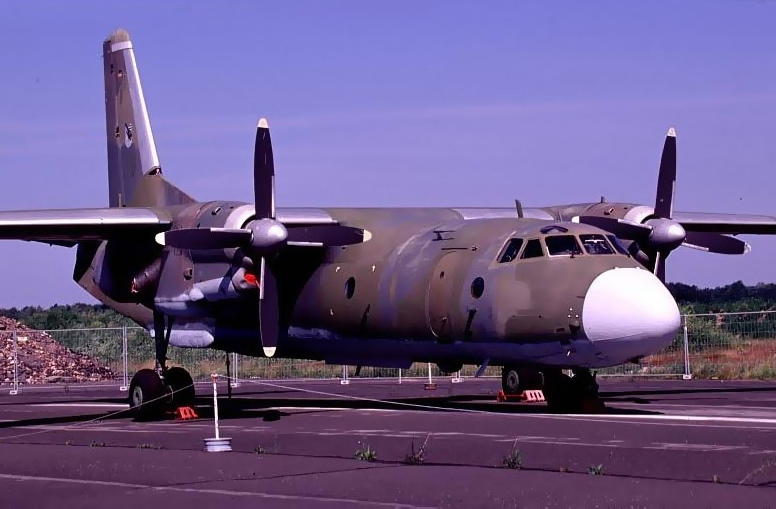
So there is a respected reader - you were not mistaken, in this publication we will talk about the bomber brand "An", designed under the leadership of Soviet aircraft designer Oleg Konstantinovich Antonov. The world famous O.K. Antonov became after the creation of a number of very successful transport and passenger aircraft. But now, few people remember that his firstborn - the piston biplane An-2, in addition to the transport and passenger version, was designed as a light reconnaissance spotter and night bomber.
Work on the combat version of the "maize" began in the OKB-153 in the spring of 1947 of the year. According to the project, it was supposed to be a three-seater aircraft designed for night reconnaissance, adjusting artillery fire and making night bombing attacks, with the possibility of landing on unpaved airfields with a small runway. The characteristics of the An-2, its low speed, high maneuverability, minimum mileage and run-up were fully suitable for these tasks.
The aircraft, which received the symbol "F" ("Fedya") had a lot in common with the base An-2. In order to improve the convenience of combat use, the fuselage and tail assembly have been reworked. Closer to the tail section was mounted the cockpit of the observer, which resembled a cage and was a glazed truss structure. In order to ensure ease of use of defensive weapons in the rear hemisphere, tail tails were made with spaced keels.
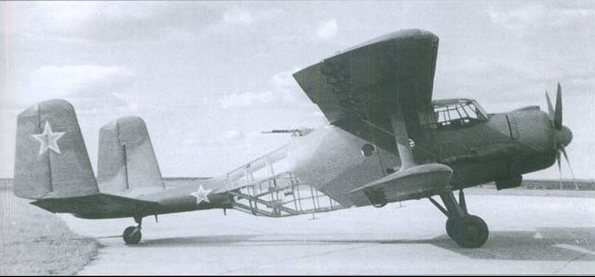
To repel the attacks of enemy fighters from the rear hemisphere behind the upper wing, they installed a turret with the X-NUMX-mm B-20 cannon. In the lower right-hand plane, another fixed 20-mm cannon that fired forward was mounted. Crew jobs and the engine received armor protection. When used as a night bomber, the aircraft could carry twelve 20 kg bombs in cassettes placed in the fuselage, under the lower planes there were four holders for 50 kg bombs or NAR blocks.
Tests An-2NAK (night artillery spotter) successfully completed in early 1950. But in connection with the development of reactive aviation serially the plane was not built. Further events showed the fallacy of this decision. During the fighting on the Korean Peninsula in the early 50s, night bombers Po-2 and Yak-11 were very effectively used. Due to the low speed, the accuracy of the bombing from Po-2 biplanes was very good, and the “flying shelves” themselves, due to the large difference in speed and high maneuverability, proved to be a very difficult target for American night fighters. There are several cases where night interceptors crashed while trying to shoot down Po-2s flying at night at low altitude. North Korean light bombers, usually operating over enemy trenches and in the front line, were a real nightmare for the UN forces. Po-2 took 100-150 kg of small-caliber bombs, which paralyzed automobile traffic in the immediate rear and terrorized targets on the front line of the enemy. American soldiers called them - "crazy Chinese alarms." It seems that the An-2NAK night bomber, which had speed and maneuverability similar to the Po-2, could be much more effective in Korea with a higher payload.
Successful use of converted "corncob" in a number of military conflicts prompted the designers to return to the topic of military use of An-2. At the beginning of 1964, the An-2 modified An-XNUMX with strike armaments was tested at the airfield of the Scientific Research Institute of the Air Force in Chkalovsky.
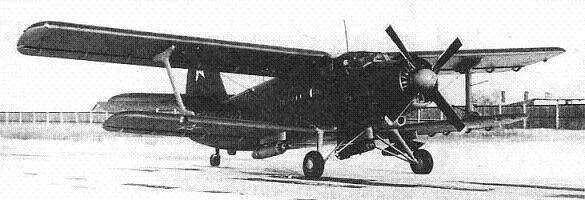
The rifle and bomb sights were installed on the plane, the weapons consisted of NAR UB-16-57 units and 100-250 caliber bombs. For suspension arms on the An-2 mounted beam holders BDZ-57KU. In the portholes and the lining of the cargo compartment were made devices for firing from Kalashnikov assault rifles. The test results of the military were not impressed and work on this topic was no longer conducted in the USSR.
Despite the fact that the “combat” version of the An-2 did not go into the series, this aircraft, which was not originally intended for war, repeatedly participated in hostilities in various parts of the world. The first reliably known case of combat use of An-2 occurred in Indochina in 1962, when North Vietnamese An-2 delivered cargo to its allies in Laos - left neutralists and Pathet Lao detachments. In the course of such flights, the “maize farmers” were often fired from the ground. To suppress anti-aircraft fire on An-2, 57-mm NAR C-5 blocks were suspended and machine guns were installed in doorways.
The next step for the air forces of the DRV was the targeted night attacks of the South Vietnamese and American warships and ground bases. It is a well-known case when the An-2 group in a night combat sortie with the help of NURS sank a guard and damaged the naval landing ship of South Vietnam. But a similar attack on destroyers of the US Navy, firing on the coast at night, failed. The Americans, who controlled the airspace of the radar, in time detected the approaching An-2 and shot down one biplane with an anti-aircraft missile.
Much more successful Vietnamese An-2 acted against armed boats and junks, which were used by American and South Vietnamese sabotage and reconnaissance teams.
The end of the Vietnam War did not put an end to the combat career of the "corncob". After entering the Vietnamese forces in 1979, Cambodia, An-2 was attacked by Khmer Rouge units. Often they were used as advanced aircraft builders. Pilots of An-2, having found the target, “processed” it with bombs and NURS. Incendiary phosphorus grenades were used to indicate the target and guidance of other more high-speed attack aircraft, while burning white phosphorus, a thick, well-marked white smoke was used, which served as a guide. Interestingly, the F-2 and American-made A-5 fighter jets were used for air strikes in Cambodia on the Khmer Rouge, along with low-speed An-37.
The next time An-2 entered the battle in Nicaragua at the start of the 80's. Several Sandinistas farm planes equipped kg bombs with 100 holders. In this form, the aircraft were involved in the bombing of the CIA-supported "contras" detachments.
A little-known page of the combat use of the An-2 is the war in Afghanistan. In addition to transporting cargo to field airfields, these vehicles were used by the Afghan Air Force as light reconnaissance and spotters. Kishlaks occupied by detachments of the armed opposition bombed them several times. Good maneuverability and low infrared signature of a piston engine helped them avoid missiles from MANPADS. In the event that An-2 anti-aircraft machine guns came under fire, they switched to a low-level flight or dived into the gorges. Repeatedly Afghan An-2 returned to the airfields with holes, but in the reports of combat losses are not.
An-2 also occasionally participated in various conflicts in Africa. Machine guns mounted turrets were made handicraft on airplanes, and for bombing ground targets, hand grenades and industrial explosives were used as a rule.
The scale of the military use of the An-2 in ethnic conflicts in the territory of the former Yugoslavia turned out to be much larger. In Croatia, a bomber squadron was established in Osijek on the basis of the Agricultural Aviation Detachment, which was armed with about a dozen An-2. Since November, 1991, the Croatian "twos" were involved in night bombing of the positions of the Serbs, in total, they made more than 60 sorties. At the same time, improvised bombs were used, dropped through an open door. In view of the low infrared visibility of An-2, it turned out to be a difficult goal for Serb-owned Strela-2М. There is a case in which, in order to bring down a Croatian piston biplane at night, the Serbian military spent 16 missiles of MANPADS. Another An-2 was hit by the Kvadrat anti-aircraft missile system. In total, during the fighting near the city of Vukovar, the Croats lost at least five An-2. In addition to actions against Serbian military installations, the Croatian Ana were used several times in raids on Serb refugee convoys, which is a war crime.
In January-February, 1993, the Croatian An-2, bombed the positions of the troops and important objects of the self-proclaimed Republic of Serbian Krajina. During the raid on the oil field near the village of Dzheletovitsi, one An-2 was shot down. The crew managed to make a forced landing safely, but, trying to escape from pursuit, the pilots exploded in a minefield.
In 1992, the Croats used their An-2 during battles in the territory of the former Federal Republic of Bosnia and Herzegovina. There, one aircraft burned in the air after hitting an 57-mm C-60 anti-aircraft projectile. The Bosnian Serbs got the equipment of local flying clubs, they used the An-2 as scouts and light attack aircraft. In March, 1993, when bombing Muslim positions near Srebrenica, one aircraft was shot down.
Cases of the combat use of An-2 during the Armenian-Azerbaijani conflict in Nagorno-Karabakh were noted. According to media reports, one Armenian An-2 crashed after being damaged by anti-aircraft fire.
In Chechnya, General Dudayev had at his disposal several serviceable An-2. It is known that some of them were prepared for use as night bombers. But they did not have time to take part in the hostilities; all of them were destroyed in early December 1994 by Russian aircraft at home bases.
The use of “twos” in combat was usually of a forced nature. Transport and passenger, agricultural and Aeroclub aircraft made combat missions after minimal re-equipment and training.
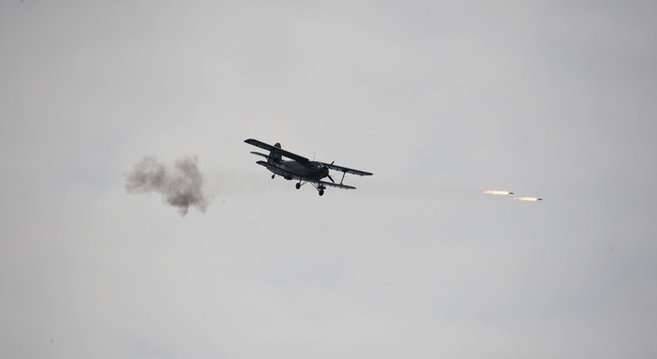
A completely different approach was to the use of An-2 for military purposes in the DPRK. A considerable part of the Soviet and Chinese biplanes in North Korea were modernized at aircraft repair enterprises. To reduce the visibility at night, the planes were painted black, rifle turrets were mounted in the doorways and in the portholes. Under the lower planes and the fuselage mounted holders for bombs and blocks NAR. In addition to the shock functions, the “two” were assigned the task of entering reconnaissance and saboteurs on the territory of South Korea. They crossed the line of demarcation at extremely low altitudes, remaining invisible to South Korean and American radars. Currently, the North Korean An-2, captured by South Korean special services during one of these missions, is being demonstrated at the Military Museum in Seoul.
In addition to the first-born An-2, other vehicles created by the Antonov Design Bureau were often involved in bombing land targets. In 1957, the serial construction of the An-12 medium military transport aircraft began. It was the first Soviet production vehicle with four AI-20 turboprop engines. In total, more than 1957 aircraft of this type were built at three aircraft plants from 1973 to 1200. The design of the fuselage of the An-12 transport almost completely coincided with the design of the fuselage of the passenger An-10. The main difference between the An-12 was the aft, where there was a cargo hatch and a rifle installation.
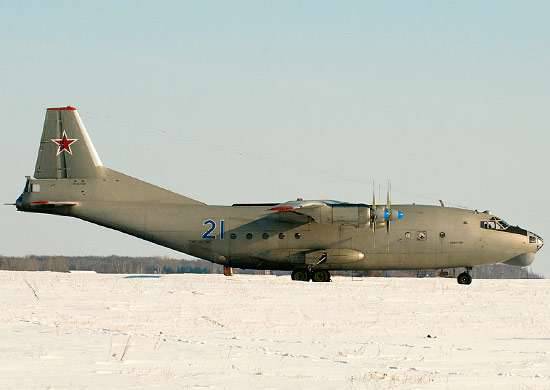
An-12 significantly expanded the capabilities of the Soviet Airborne Forces. This aircraft could transfer not only 60 paratroopers, but also heavy equipment and weapons weighing up to 21 tons with a cruising speed of 570 km / h. Flight range with a normal load - 3200 km.
From the very beginning, the An-12 had provided for the suspension of bombs for various purposes. OPB-1Р and NKPB-7 and RBB-2 panoramic radar for determining the point of discharge of cargo out of sight of the ground are available to the navigator for the aiming bombing and dumping of the landed cargo.
There were several options for the placement of bomb weapons. On the right side of the fuselage there was a bomb bay with a hatch for two bombs in caliber from 50 to 100 kg or six bombs in caliber 25 kg. Also, small-caliber bombs were suspended on beams in the front parts of the chassis fairings. Thus, special-purpose bombs were usually located: approximate-signal, lighting, photographic, etc. In the rear fuselage there is a box holder for vertical suspension 6 bombs or radio probes.
In 1969, a bomber and director of sea mines AN-12BKV successfully passed tests. The discharge of the combat load from the cargo compartment was carried out using a special stationary conveyor through an open cargo hatch. In the cargo hold it was possible to place up to 70 bombs with a caliber of 100 kg, up to 32 250-kg or 22 bombs with a caliber of 500 kg. There was the possibility of loading 18 sea mines UDM-500. During the tests, it turned out that the acceptable effectiveness of bombing with An-12БКВ can be carried out only for area targets. The main reason was the large dispersion of bombs dropped by a transporter from an open cargo hatch. In addition, there were no special bomber sights on the plane, and the capabilities of the existing full-time day and night sights were not enough. However, at the aircraft factory in Tashkent, the An-12BKV aircraft were built in a small series. Later, the construction of special "bomber" modifications was abandoned. If necessary, all the combat transport modifications of the An-12 could be quickly converted into bombers after the installation of a special transporter TG-12МВ.
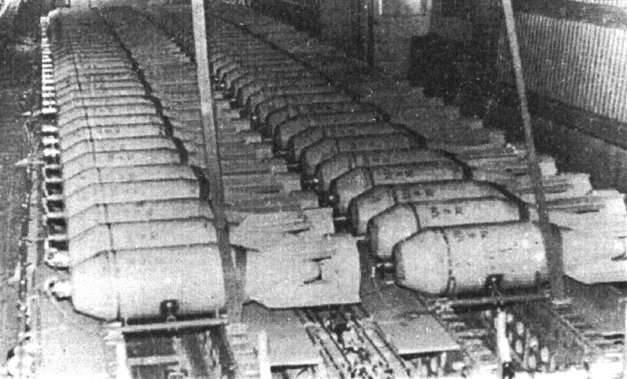
The standard loading scheme provided for placing in the cargo compartment up to 42 100 kg aerial bombs, up to 34 bombs of caliber 250 kg and up to 22 RBC-500 or 18 500 kg fugasok. Great difficulties arose with the loading of large-caliber bombs FAB-1500М54 and FAB-3000М54. These aircraft munitions differed solid dimensions. Heavy bombs were dragged into the cargo hold of the aircraft with the help of winches, placing wooden rollers under them. The width of the bombs in the package exceeded a meter, and the length was more than three meters, which is why An-12 could take no more than three pieces, stacked one after the other along the entire length of the cargo compartment.
The most rational from the point of view of covering areal and extended targets was the loading of 250 kg and 500 kg of bombs and one-time bomb cassettes. The An-12 transport aircraft as a heavy bomber in terms of the mass of a bomb salvo could be compared to a squadron of Su-7B fighter bomber. An-12 also proved to be very effective in the role of director of naval mines. The relatively low speed and the possibility of stable flight at low altitude made it possible to place mines with good accuracy and with relatively little dispersion. A big plus of transport vehicles in comparison with other specialized attack aircraft was lower operating and fuel costs when performing a similar task.
Bombing with An-12 could only be carried out from horizontal flight without any maneuvering. The presence of anti-aircraft cover in the target area for a bulky and slow transport could be fatal. However, since the beginning of the 70-s, the training plans for training crews of military transport aircraft included the tasks of testing the bombing. An-12, delivering bombing strikes to the squares, could perform the task of “stripping” the landing area, thus reducing possible losses among paratroopers.
For the first time in the real combat situation of the An-12, the Indian Air Force was used as a bomber. The crews of the Indian Air Forces, whose An-12 were equipped with bomb weapons during the war with Pakistan, in 1971, attacked airfields, weapons depots and fuel storages. The mass of the combat load at the same time reached 16 tons.
After the first successful raids against stationary objects, Indian An-12 switched to night bomb strikes directly in the battle formations of the enemy troops. To improve the accuracy of the bombing was often conducted from low altitudes, which required the pilots considerable courage and professionalism. The use of powerful 250-500 kg bombs from low altitudes was a very dangerous matter, with a close break the bomber itself could hit the fragments. Therefore, in the case of low-altitude bombing, incendiary napalm tanks were used predominantly, their fire breaks had a strong demoralizing effect on Pakistani soldiers.
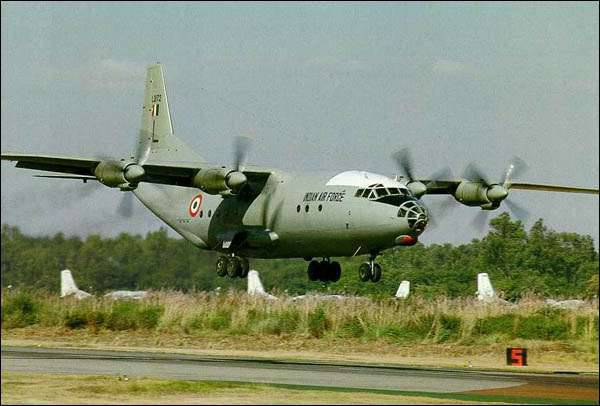
The effectiveness of the nightly loaded An-12 transport bombs turned out to be even higher than the specialized Canberra British-made jet bombers. In total, the An-12 Indian Air Force made several dozen night combat missions, without losing a single aircraft. Pakistanis have repeatedly raised Mirage-3 and F-104 fighters to intercept, but Indian An-12 each time managed to evade them.
The Soviet Air Forces actively used An-12 for bombing during combat operations in Afghanistan. Unlike the ground attack aircraft and fighter-bombers, which operated at the request of the ground forces, the work of the An-12 was routinely planned. Loaded with powerful “Ana” bombers, they bombed fortifications and rebel bases from a safe height, inaccessible to MANPADS and small-caliber anti-aircraft installations. Of course, the accuracy of such bombings was low, but it was compensated by the number and caliber of the bombs. Part of the bomb bombs was placed with a deceleration from several hours to several days. This should have made restoration work more difficult, and simply made it dangerous to be in the area subjected to a bomb strike. In addition to reliably known locations of the rebels, caravan routes from Pakistan and Iran were subjected to large-caliber bombs in order to create impassable debris and collapse of mountain canopies in border mountain areas.
In Afghanistan, unexpectedly, there was a job for the onboard shooters of the rear defensive firing point. After several airplanes were shot down and damaged on the takeoff and landing of MANPADS and ZSU fire, the side gunners began to comb through their firefighting 23-mm guns with suspicious places in the vicinity of airfields. It was difficult to say how effective it was, but this precaution, combined with the abundantly fired heat traps, had a beneficial effect on the mental balance of the An-12 crews. After the Soviet contingent was withdrawn from Afghanistan, the Afghan Air Force also practiced bombing military transport aircraft from aircraft. But unlike the Soviet Air Force, their bomb strikes were often unsystematic and had little effect.
In 90-2000-ies, created for transportation, An-12 became one of the most belligerent aircraft on the African continent. As of 1998, there were six An-12 in the Ethiopian Air Force. At the initial stage of the Ethiopian-Eretrias conflict, Ethiopian transport workers repeatedly bombed Eretrias armed units. However, shortly after the appearance in Eritrea of the Kvadrat SAM and MiG-29 fighters received from Ukraine, the An-12's bombardment flights stopped.
Transport aircraft were used very widely for strike purposes during the civil war in Angola from 1992 to 2002. An-12, along with An-26, bombed the positions of the armed detachments of the UNITA movement. Loaded with dozens of bombs and napalm tanks from safe heights, they plowed and burned hectares of jungle. Unable to reach "Ana" on a combat course, UNITA militants began to catch transport aircraft during takeoff and landing, without making a distinction in the nationality of the aircraft. The victims of MANPADS and anti-aircraft guns in the vicinity of Angolan airfields were about 20 An-12 and An-26, including those with Russian crews.
In the middle of 90, An-12 in Zaire rained bombs on the jungle in an attempt to stop the offensive against the capital of Kinshasa, anti-government rebels. However, after the overthrow of the dictatorship of President Mobutu in 1997, peace never came to this country. Zaire, which has now become the Democratic Republic of the Congo, has been embroiled in the "Great African War." This large-scale armed conflict, which was not widely reported in the world media, was in fact provoked by transnational corporations, which started a war for the redistribution of property of the richest natural resources of central Africa. The victims of the war, the active phase of which lasted from 1998 to 2002 a year, were more than 5 million. Large-scale military operations were conducted by all available means, and the five in-flight condition available in the DRC air force were actively used as bomb carriers. However, the case was not without foreign intervention, An-12 of the Angolan Air Force took part in the bombing of the Congolese territory.
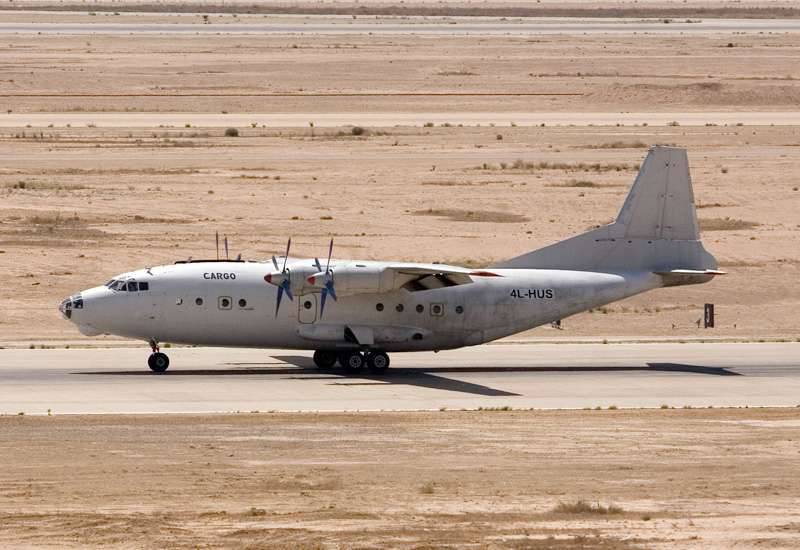
Currently, the An-12 vehicles located abroad are not much left in the flying state. Production of this aircraft ended more than 40 years ago, and, despite the repeated extension of the resource, their career is coming to an end.
In 1962, the passenger An-24 with two AI-24 turbo-prop engines went into the series. An aircraft weighing about 22000 kg could carry 50 passengers or 6500 kg of cargo for a distance of about 1500 km.
In addition to the passenger option for cargo and use as a military transport produced An-24T. This aircraft was distinguished by the presence of large doors that facilitated loading and unloading, a cargo hatch in the rear fuselage section, an increased fuel reserve, a reinforced cargo compartment floor, a loading device on the ceiling, and folding seats along the sides. In addition to performing transport tasks, An-24T could be used as an auxiliary bomber.
In the spring of 1969, state tests of aircraft bomber weapons were held at the Crimean airfield of Kirovskoye. It included four girder holders BDZ-34, a bomb drop system and an optical sight OPB-1Р. According to the test results, the following conclusion was made: “An-24T bomber armament provides the possibility of bombing bombs in caliber not more than 500 kg, with optical visibility of the target at flight speeds of 260 - 480 km / h at altitudes from 600 to 6000 m” That is, as follows from the flight characteristics of the An-24T bomber, it approximately corresponded in terms of its shock capabilities to the long-range bombers of the Second World War. In the same year 1969, the An-24Ts set in Iraq were used to bomb Kurdish positions. Thus, these machines were the first in their family to take direct part in hostilities.
But more often An-26 was used for bombing. This aircraft was a further development of the An-24T and differed from it by the onboard equipment and the tail part of the fuselage with a large cargo hatch, which was closed by a ramp of the original design. It provides a tight closure, serves as a ladder when loading self-propelled vehicles, can move under the fuselage, allowing loading from a loading platform or car body.
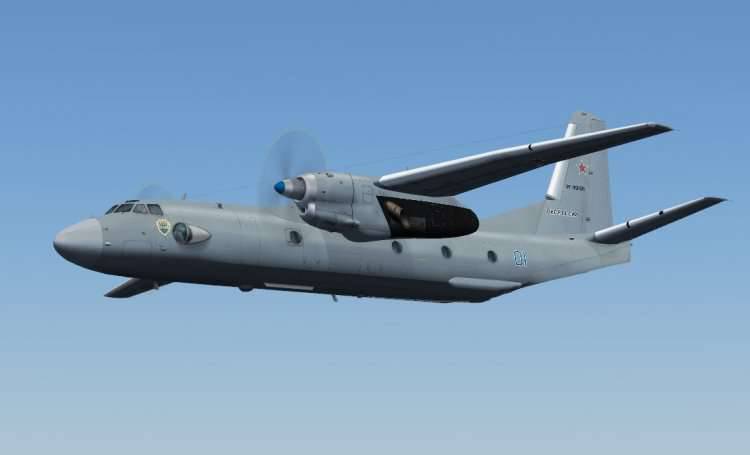
A total of 1969 to 1986 year built 1398 machines of various modifications, including for export. After the start of operation of the aircraft in the USSR Air Force, the question arose of its use as an auxiliary bomber. In the first half of 1972, at An-26, the installation of bomber weapons was completed. For this purpose, the machine was equipped with a NKPB-7 sight, four beam holders BDZ-34 and equipment for dropping bombs. As a result of the work carried out on the An-26, it became possible to use a large number of suspension options, including various bombs in caliber up to 500 kg. The external bomb suspension lowered the rate of climb and maximum speed, but had practically no effect on the stability characteristics of the aircraft and controllability.
For aiming when dropping cargo and bombing, the NKPB-7 sight and a radar near-navigation system operating in the mode of viewing the earth's surface and the forward hemisphere are intended.
The twin-engine An-26 was used as a bomber even more often than the more heavy-lifting An-12. The first to "smell gunpowder" happened An-26 Air Force of Ethiopia. In July, 1977, the “twenty-sixths” participated in repelling the aggression of Somali troops. After the conquest of air supremacy by the Ethiopian fighters, in addition to supplying their units, "Ana" was attracted to bombard enemy positions. In subsequent years, the Ethiopian An-26 was often used against various rebel groups and separatists within the country.
From 1976 to 1984, the X-NUMX of the An-24 aircraft was delivered to Angola. During the ongoing civil war, "transport workers" were actively used as bombers. The bombing of the positions of the anti-government group of UNITA was mainly by Cuban crews. At particularly tense moments, Cubans had to perform 26-4 sorties daily. Several Angolan cars were lost on takeoff and landing, as well as during the shelling of airfields.
In the first half of the 80's eight, An-26 acquired Mozambique, where civil war also lasted for a long time. Here for the “twenty-sixths” who acted as bombers, there was also a lot of work.
In 1977, 16 An-26 received the Peruvian military. They were very interested in the shock capabilities of transport vehicles. In the presence of specialists from the USSR in 1979, experimental discharges of tanks filled with water were carried out. Soon in the 1981 year, the skills gained from these experiments were Peruvian An-26 crews put into practice during the armed conflict with Ecuador. Peruvians loaded 16 barrels of napalm on the transporter An-26 installed in the cargo hold and then used them very effectively to destroy enemy positions in the remote jungle. Subsequently, similarly, An-26 acted against the Sendero Luminoso ultra-leftist terrorist group.
The next Latin American buyer, An-26, was Nicaragua. From 1982 to 1985, this country received a twenty-sixth 5. They were actively used for reconnaissance and bombardment of areas where anti-government "contras" were concentrated.
The Vietnamese An-26, in addition to delivering goods to support the actions of the military contingent in Cambodia, flew out to explore and bombed the camps and the troops of the half-soldiers who were hiding in the jungle.
An-26 of various nationalities bombed during the aforementioned “Great African War”, which raged in late 90 and early 2000-x on the territory of the Democratic Republic of Congo with the participation of military contingents of Rwanda, Uganda, Namibia, Zimbabwe and Angola.
From 2011 to 2012, international observers have documented numerous instances of using the An-26 as a bomber in South Sudan. The aircraft of the Governmental Air Force of Sudan, operating at altitudes above 4000 meters, carried out several dozen combat missions. As reported, Sudanese aircraft participating in the raids, have been finalized with a view to their optimal use as a bomber. In this case, the bombs were loaded into the cargo compartment and dropped through the cargo hatch in the tail section of the aircraft. In addition to standard aviation munitions, widely used were hand-made bombs filled with ammonium nitrate and incendiary liquids.
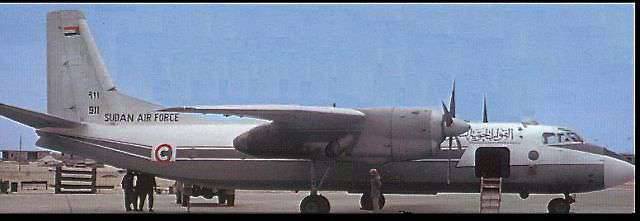
The strikes were carried out mainly on settlements and South Sudanese troops in the area of South Kordofan. International observers have repeatedly recorded cases of the bombing of refugee camps and purely civilian objects, but every time the authorities in Khartoum denied this. Sudanese President Omar al-Bashir is accused of numerous war crimes. In 2008, the International Criminal Court issued an arrest warrant for al-Bashir on charges of genocide and ethnic cleansing during hostilities in Darfur. Thus, al-Bashir became the first acting head of state, against whom the accusation was made by the body of international justice.
The raids of the Sudanese An-26 stopped after the U-s of Uganda's C-125 was deployed in South Sudan. Uganda purchased four S-125 and 300 SAM systems in Ukraine in 2008 year.
Recently, in connection with the aggravated international situation and the general increase in the level of combat training, the shock use of the An-26 of the Russian Aerospace Forces has been conducted. The transformation of a military transport aircraft into a bomber does not take much time: for this purpose, special pylons are attached, thanks to which the aircraft can take four bombs weighing from 50 to 500 kilograms.
Testing the use of bombing weapons on the An-26 in our Air Force was introduced more than 40 years ago. But with the beginning of the process of “reforming” the armed forces for more than 20 years, such training was stopped, and now they have been decided to resume. The use of the An-26 military transport aircraft as a night bomber is one of the most difficult combat training tasks for a crew combat training course. In the course of combat training, it is planned to work out the bombing of land and sea targets.
Bombing with the An-26 is carried out in the altitude range of 1200-3000 meters, at a speed of 350 kilometers per hour. To get an excellent mark, the bomb must fall into a circle with a diameter of 63 meters. Another exercise involves training bombing from heights of 500-900 meters on a group of targets that mimic tank enemy column. In both cases, NKPB-7 sights are used. Defeat targets using this fairly old sight does not require the use of radar and allows you to perform a combat mission at night as stealthily as possible.
Such training has recently been held in a number of aviation units operating the An-26. In August 2015, training pilots for combat use were carried out by Baltic transport aviation pilots fleet. They practiced bombing at the command post of a conditional enemy. In October 2015, the An-26 military transport aircraft, during training near St. Petersburg, successfully hit targets that mimic enemy tanks.
In Soviet times, the An aircraft were the hallmark of the Soviet aircraft industry and were operated in dozens of countries, demonstrating high efficiency and reliability. Construction of the An-12 in the first half of the 70-x was discontinued due to the advent of the IL-76, which later became the main aircraft for the Airborne Forces. In connection with the collapse of the Soviet Union and the ambitions of the Ukrainian authorities, the project of promising turboprop An-70 was buried. Also, there is still no adequate replacement for the passenger An-24 and the military transport An-26. In connection with the aging of the aircraft fleet and the sad events in Ukraine through the coming 10 years, the An-brand aircraft will most likely become a rarity in our sky.
Based on:
http://www.airwar.ru/enc/craft/an26.html
http://www.redov.ru/transport_i_aviacija/aviacija_i_vremja_1995_02/p2.php
http://maxpark.com/community/14/content/1720795
http://www.rovingbandit.com/2012/04/how-sudanese-bombers-work.html
https://soldadosyuniformes.wordpress.com/2012/09/
http://fas.org/man/dod-101/sys/ac/row/an-12.htm
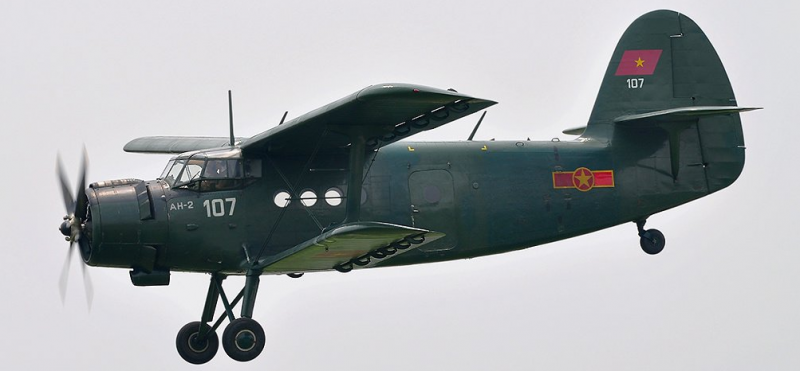
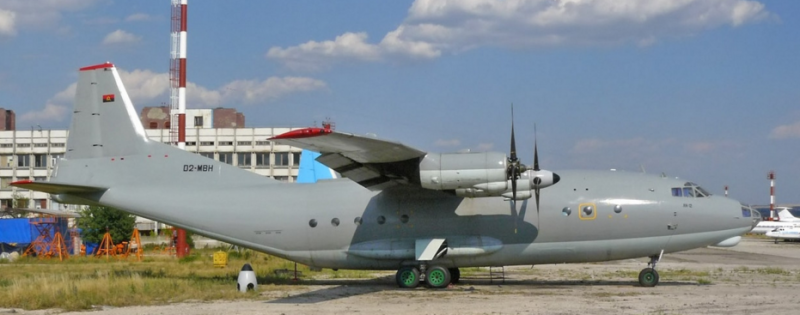
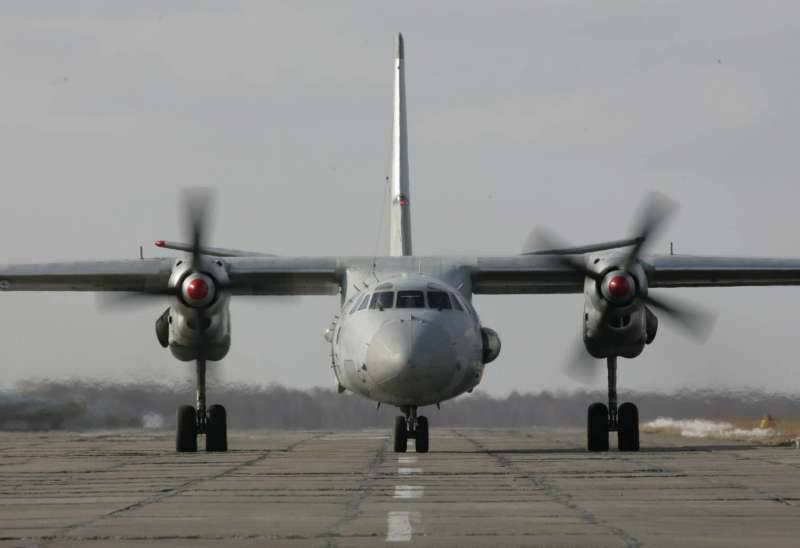
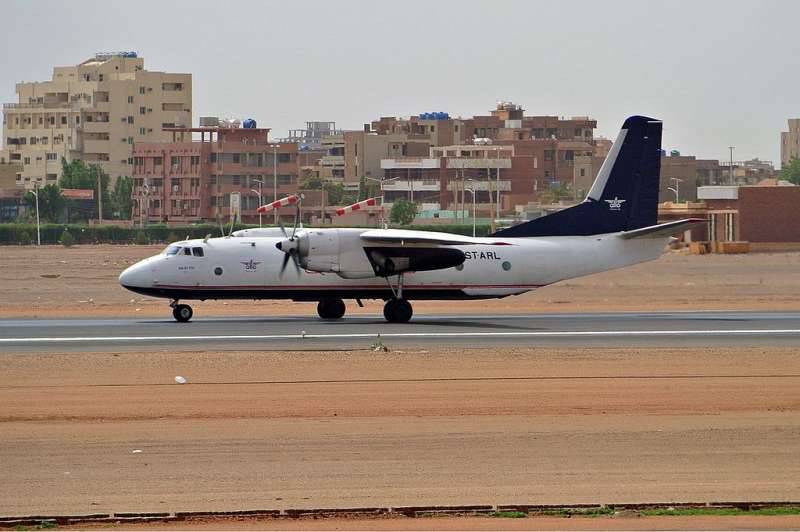
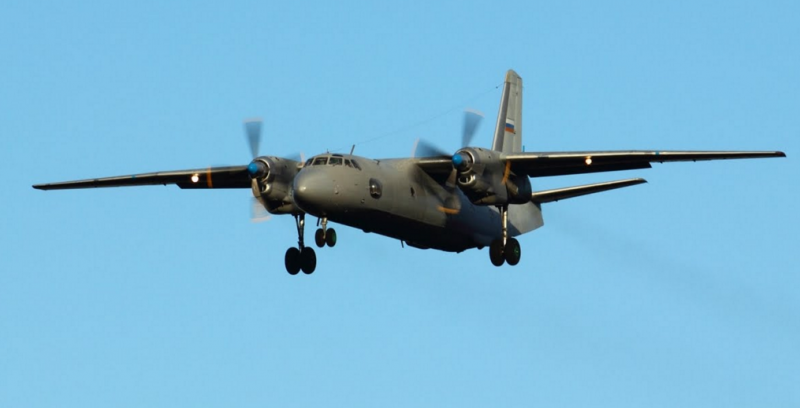
Information